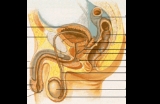
Foreskin
Overview
In male
human anatomy
, the foreskin is a generally retractable double-layered fold of skin and mucous membrane that covers the glans penis
and protects the urinary meatus
when the penis
is not erect
. It is also described as the prepuce, a technically broader term that also includes the clitoral hood
in women, to which the foreskin is embryonically homologous
.
The outside of the foreskin is a continuation of the skin on the shaft of the penis, but the inner foreskin is a mucous membrane
like the inside of the eyelid or the mouth.
Male
Male refers to the biological sex of an organism, or part of an organism, which produces small mobile gametes, called spermatozoa. Each spermatozoon can fuse with a larger female gamete or ovum, in the process of fertilization...
human anatomy
Human anatomy
Human anatomy is primarily the scientific study of the morphology of the human body. Anatomy is subdivided into gross anatomy and microscopic anatomy. Gross anatomy is the study of anatomical structures that can be seen by the naked eye...
, the foreskin is a generally retractable double-layered fold of skin and mucous membrane that covers the glans penis
Glans penis
The glans penis is the sensitive bulbous structure at the distal end of the penis. The glans penis is anatomically homologous to the clitoral glans of the female...
and protects the urinary meatus
External urethral orifice (male)
The external urethral orifice is the external opening or meatus of the urethra, normally placed at the tip of glans penis; it presents as a vertical slit, possibly bounded on either side by two small labia-like projections, In some cases the slit may be more rounded. This occurs naturally in some...
when the penis
Human penis
The human penis is an external sexual organ of male humans. It is a reproductive, intromittent organ that additionally serves as the urinal duct.-Parts:...
is not erect
Erection
Penile erection is a physiological phenomenon where the penis becomes enlarged and firm. Penile erection is the result of a complex interaction of psychological, neural, vascular and endocrine factors, and is usually, though not exclusively, associated with sexual arousal...
. It is also described as the prepuce, a technically broader term that also includes the clitoral hood
Clitoral hood
In female human anatomy, the clitoral hood, , is a fold of skin that surrounds and protects the clitoral glans. It develops as part of the labia minora and is homologous with the foreskin in male genitals.-Variation:This is a protective hood of skin that covers the clitoral glans...
in women, to which the foreskin is embryonically homologous
Homology (biology)
Homology forms the basis of organization for comparative biology. In 1843, Richard Owen defined homology as "the same organ in different animals under every variety of form and function". Organs as different as a bat's wing, a seal's flipper, a cat's paw and a human hand have a common underlying...
.
The outside of the foreskin is a continuation of the skin on the shaft of the penis, but the inner foreskin is a mucous membrane
Mucous membrane
The mucous membranes are linings of mostly endodermal origin, covered in epithelium, which are involved in absorption and secretion. They line cavities that are exposed to the external environment and internal organs...
like the inside of the eyelid or the mouth.
Unanswered Questions
Discussions

